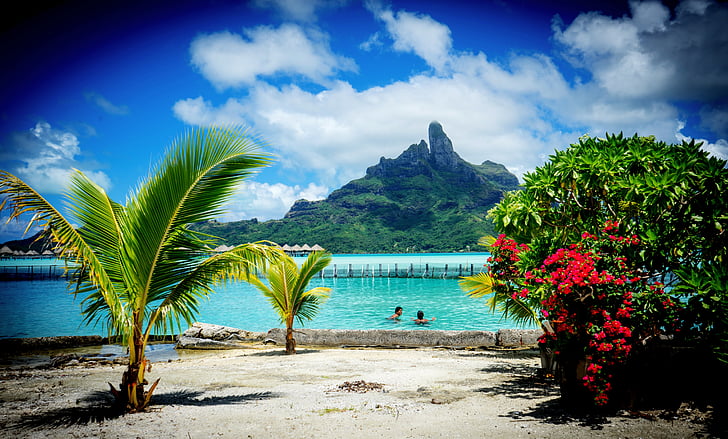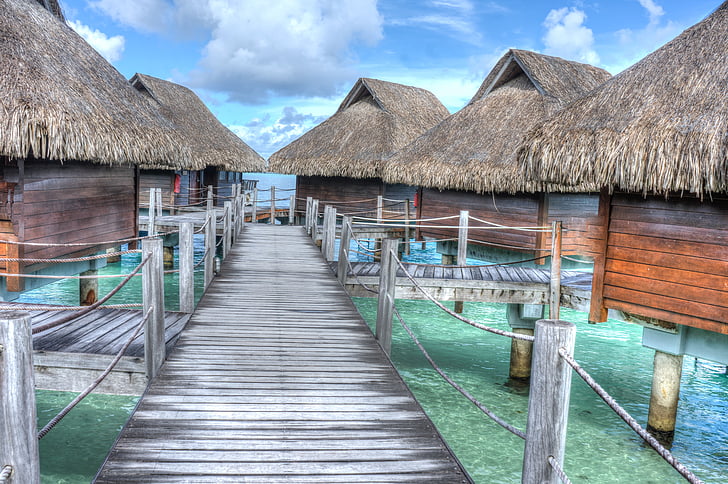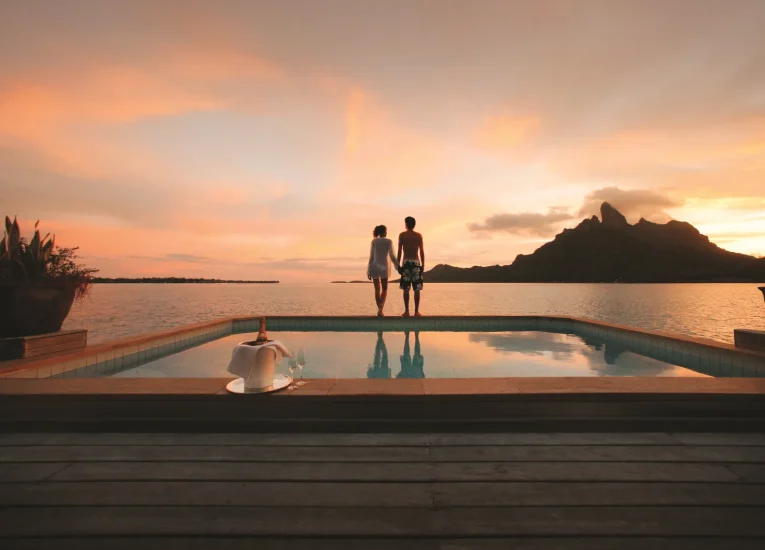Bora Bora, known as Pora Pora in Tahitian, is an enchanting island group nestled in the Leeward Islands of the South Pacific. Positioned within the western expanse of the Society Islands in French Polynesia, it holds the status of an overseas collectivity of the French Republic in the vast Pacific Ocean. Spanning a total land area of 30.55 km2 (12 sq mi), the primary island is situated approximately 230 kilometers (125 nautical miles) northwest of Papeete. Encircled by a captivating lagoon and a protective barrier reef, Bora Bora boasts the remnants of an extinct volcano at its core, featuring two prominent peaks, Mount Pahia and Mount Otemanu, with the highest point reaching 727 m (2,385 ft).
Part of the Commune of Bora-Bora, which also includes the neighboring atoll of Tūpai, the prevailing languages in Bora Bora are Tahitian and French. However, owing to its substantial tourist influx, many locals have adeptly acquired proficiency in English.
Bora Bora has risen to prominence as a leading international tourist destination, renowned for its opulent seaside and offshore luxury resorts. The primary settlement, Vaitape, graces the western shoreline of the main island, facing the principal channel that guides visitors into the mesmerizing lagoon. While the island's agricultural output is primarily derived from the bountiful sea and the abundance of coconut trees, historically significant for copra production, Bora Bora captivates visitors with its natural beauty and hospitality.
In antiquity, the island bore the name "Pora pora mai te pora," signifying "created by the gods" in the local Tahitian language. This was commonly shortened to "Pora Pora," meaning "first born." Due to the distinctive set of phonemes in Tahitian, which differs from English, French, and Dutch, the spelling and pronunciation of the name undergo alterations as it transitions between languages. Tahitian lacks a clear distinction between the sounds and , with the sound denoted by lying between the two[citation needed]. Additionally, in Tahitian represents a sound akin to and, absent in English.
English, French, or Dutch speakers may inadvertently alter the Tahitian pronunciation, interpreting "Pora Pora" as "Bola Bola" or "Bora Bora." This linguistic nuance led explorer Jacob Roggeveen and his crew to adopt the name "Bora Bora" upon their initial landing on the island, a designation that has endured ever since.
History
Polynesian settlers first inhabited the island of Bora Bora around the 3rd century, marking its ancient roots. The inaugural European sighting transpired in 1722, when Jakob Roggeveen laid eyes on the captivating landscape.
James Cook, aided by Tahitian navigator Tupaia, sighted the island on 29 July 1769. The arrival of the London Missionary Society in 1820 left a lasting impact, culminating in the establishment of a Protestant church in 1890. Bora Bora stood as an independent kingdom until 1888, when the French annexed it as a colony, compelling the last queen, Teriimaevarua III, to abdicate.
The island played a strategic role during World War II, selected by the United States as a South Pacific military supply base. Under the initiative named "Operation Bobcat," the U.S. constructed vital infrastructure, including an oil depot, an airstrip, a seaplane base, and defensive fortifications. This expedition comprised nine ships, 18,000 tons of equipment, and nearly 7,000 soldiers.
The 13th Coast Artillery Regiment, later renamed the 276th Coast Artillery Battalion, operated at least eight 7-inch guns strategically placed around the island for defense. Remarkably, these guns still stand today as historic remnants. Despite the military preparations, Bora Bora did not witness combat during the war, and the American presence remained uncontested. The military base officially closed on 2 June 1946. Although the World War II airstrip was never expanded to accommodate large aircraft, it served as French Polynesia's sole international airport until 1960, when Faa'a International Airport opened next to Papeete, Tahiti.
Geology
Bora Bora is part of a volcanic island group[12] shaped by the geological activity of a potentially hazardous area. It represents an extinct volcano that was active during the Upper Pliocene period, approximately between 3.45 and 3.10 million years ago. Subsequently, the volcano experienced partial depression and significant erosion under the influence of a hot and humid tropical climate.
The bay of Tuuraapuo, the primary crater of the volcano, has seen its collapsed southwestern edge preserved in the form of the islets Toopua and Toopua-iti, reaching altitudes of 148 m (486 ft) and 17 m (56 ft), respectively. The volcanic rocks predominantly consist of basaltic types, primarily alkaline basalts, alongside some hawaiites, and gabbro intrusions, notably on the islet Toopua. These formations mainly originate from voids, with infrequent explosive episodes.
Climate
As for its climate, Bora Bora experiences a tropical monsoon climate characterized by consistent temperatures throughout the year, featuring hot days and warm nights. The dry season extends from June to October, but even during these months, there is some precipitation.
Places of Interest in Bora Bora
Le Meridien, Bora Bora: A prominent attraction in Bora Bora is its mesmerizing lagoon[11], renowned for its pristine underwater world. Visitors can explore this aquatic paradise using glass-bottom boats, engaging in diving or snorkeling to witness the vibrant coral reefs teeming with colorful fish. Guided diving excursions allow tourists to feed barracudas and sharks in the deep lagoon. The "Stingray Strait" within the lagoon is a captivating site, home to schools of various stingray species, including manta rays and leopard rays.
Land Exploration: The interior of the island is ripe for exploration, and jeep safaris offer a thrilling way to discover its hidden gems. However, the true natural beauty of Bora Bora is best experienced on foot. Several hikes originating from Vaitape provide opportunities to traverse orchards, forests, orchid fields, and fern-covered crevices. The hike to the summit of Mount Pahia[21], believed to be the descent point of the war god Oro on a rainbow, offers a breathtaking journey through diverse landscapes. Mount Otemanu, another climbable peak, rewards hikers with a panoramic view of the atoll, and its lower slopes harbor a vast grotto hosting numerous frigate bird nests.
Cultural and Historical Sites: Bora Bora boasts the remnants of over 40 marae[22] (ceremonial platforms). Notable among them are Marae Fare Opu in Faanui Bay and Marae Aehau-tai or Temaruteaoa at the eastern end of Vairau Bay. Marae Marotitini, a large ceremonial site in the north of the main island, features a stone platform that was meticulously restored in 1968 by Japanese archaeologist Yosihiko Sinoto. The site also includes two stone box tombs belonging to the royal family.
Beaches and Culinary Delights: The majority of beaches, along with numerous hotels, grace the expansive bays between Pointe Paopao and Pointe Matira in the southwest of the island. Five kilometers south of Vaitape, on the main road, sits Bloody Mary's, a renowned bar and restaurant with its own yacht jetty. The entrance proudly displays two wooden plaques listing names of illustrious guests, including Marlon Brando, Jane Fonda, and Diana Ross. This establishment is a must-visit for both its culinary delights and celebrity allure.
Transportation Options in Bora Bora
For navigating the enchanting island of Bora Bora, rental cars and bicycles are highly recommended. Additionally, visitors can explore the island through exhilarating helicopter tours or opt for off-road vehicle and catamaran rentals available in Vaitape.
Ground Transportation:
- Rental Cars and Bicycles: Rental cars and bicycles offer flexibility for exploring the island at one's own pace.
- Off-Road Vehicles and Catamaran Rentals: Adventurous travelers can opt for off-road vehicles or catamarans available for rent in Vaitape, providing a unique way to discover the scenic beauty of Bora Bora.
Public Transportation:
- Le Truck (Public Bus): The main island features a public bus known as "Le Truck," circulating around the island along the ring road in approximately an hour. Stops are flexible, allowing passengers to embark or disembark wherever they desire.
Preferred Tourist Modes:
- Bicycles, Mopeds, and Motorcycles: Popular choices among tourists for a more intimate exploration of the island.
- Shuttle Service: Several hotels offer shuttle services, ensuring convenient and comfortable transportation for guests.
- Small Electric Cars: Available for rent in Vaitape, providing an eco-friendly and convenient mode of transportation.
Aerial Transportation:
- Helicopter Tours: Experience Bora Bora from the skies with helicopter tours, offering breathtaking views of the island's stunning landscapes.
- Private Helicopter Service: There is a private helicopter stationed on the island, primarily used for tourist flights, providing an exclusive and scenic way to tour the surroundings.
In conclusion, whether by land, sea, or air, Bora Bora offers a range of transportation options to suit every traveler's preference and sense of adventure.







